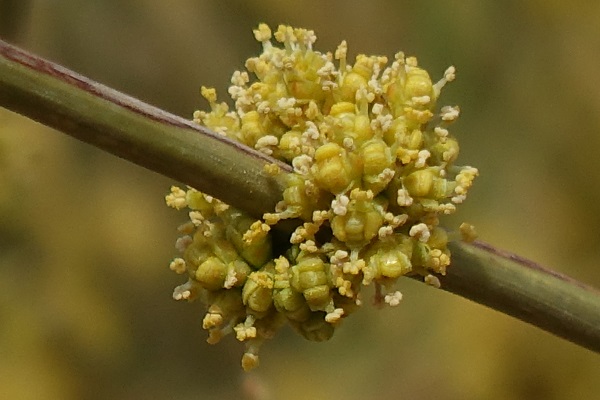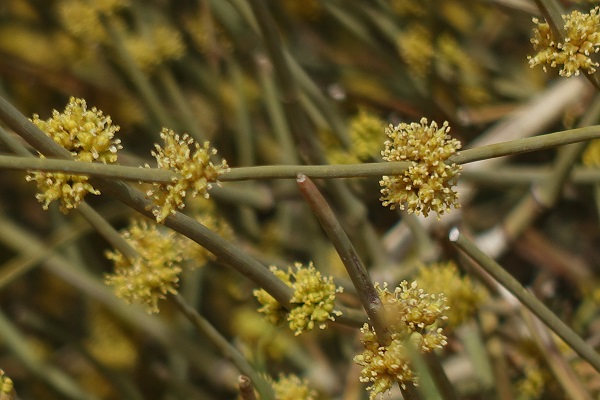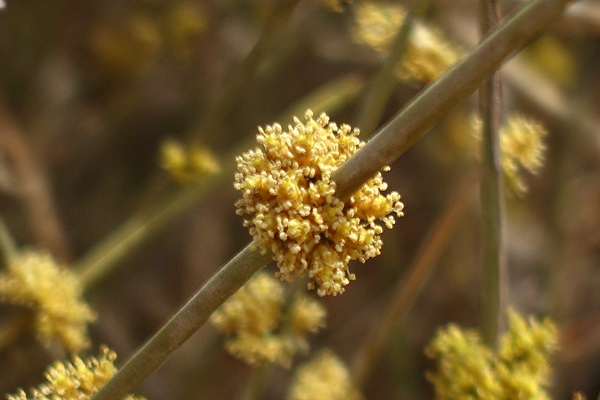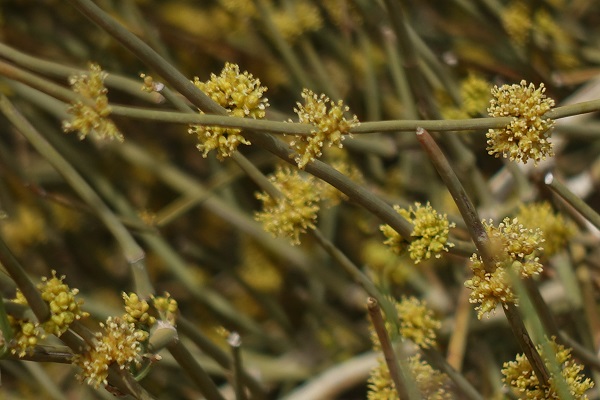Hebrew: שרביטן מכנף, Arabic: العلندى المجنحة
| Scientific name: | Ephedra alata Decne. | |
| Synonym name: | Ephedra alata Schimp. ex Carrière | |
| Common name: | White shrubby horsetail | |
| Hebrew name: | שרביטן מכנף | |
| Arabic name: | العلندى المجنحة | |
| Family: | Ephedraceae, שרביטניים |

|
| Life form: | Chamaephyte, small terrestrial shrub, up to 1 m tall; The roots are very fibrous and help the plant firmly anchor in sandy soil. | |
| Spinescence: | absent | |
| Stems: | Jointed yellowish-green, stems, much branched, erect, not climbing shrub; branches rigid, scabrous-glabrous | |
| Leaves: | Very short leaves, united towards base, forming short sheath | |
| Inflorescence: | The male spikes are borne on shoots which arise in the leafaxils or branches of the currant year or of a previous season; occasionally they arise from dormant buds on old stems. The group of flowers is terminal and the whole inflorescence unit is not a spike but a "gulbulus". | |
| Flowers: | Dioecious; The male, staminate cones terminal axillary, densely crowded, ovate, 3-8 mm long, with 3-6 long-stipitate or sessile microsporangia on a slightly exerted column. The female, ovulate cones pedunculate at nodes, oblong-ovate, up to 10 mm long, with 2 fertile flowers and 4-5 pairs of imbricated, yellowish bracts, with membranous and wavy, wing-like margin. | |
| Fruits / pods: | Seeds ovoid, acuminate | |
| Flowering Period: | March, April, May, June | |
| Habitat: | Sand | |
| Distribution: | Deserts | |
| Chorotype: | Saharo-Arabian | |
| Summer shedding: | Perennating |

Derivation of the botanical name: Ephedra, the Greek name used by Pliny for the common mare's tail (Hippuris; hippo "horse" and oura "tail") which it somewhat resembles. certain species are the source of ephedrine which, as ma-huang, the Chinese have used in medicine for centuries. alata, Latin, ala wing, armpit, wing of an army; having wings, winged. The Hebrew name: שרביטן, sharvitan, from שרביט, sharvit (scepter), because of the structure of the branches of the species.
Medicines: the stem is used for humans as a deobstruent, circular system disorders, to tread kidney disorders, as a stimulant, to treat bronchi disorders and asthma and used for the eyes. The plant (part not specified) is used for digestive system disorders. Animal food: Aerial parts. The stem is eaten by bovines, camelidae and caprines. Materials: The stem is used for the fibres to make cord, string or twine and the plant is used for tannins and dyestuffs such as tanning goat skin for water bags. This is done by grinding the leaves, roots, peel or bark, boiling in water and then the skin is added for 1-3 days. The process is called girbah. The plant is also used to control erosion in sandy areas. It will also tolerate saline soil. 

|